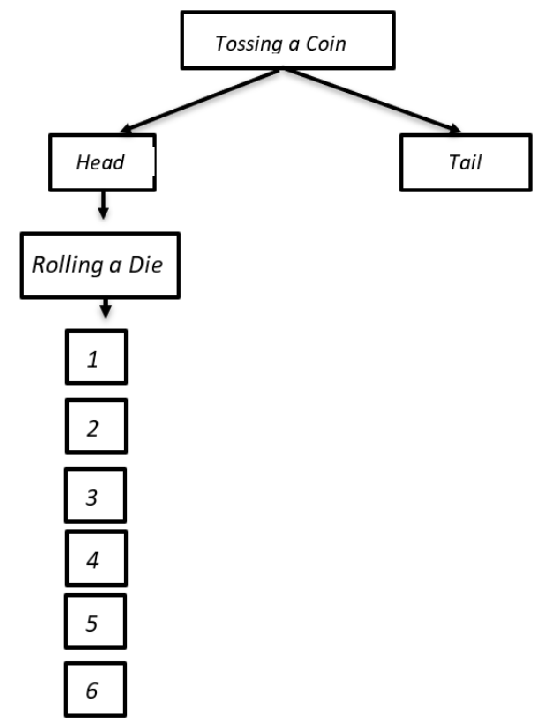
A coin is tossed and then a die is rolled only in case a head is shown on the coin. Describe the sample space for this experiment.
Answer
570.9k+ views
Hint: In a random experiment there are several possibilities that could happen. These possibilities are called Outcomes. The collection of all the outcomes of an experiment is called Sample Space. It is denoted by $S$.
Complete Answer:
In the case of a conditional experiment where the occurrence of the second experiment depends on the outcome of the first experiment, we just have to find the outcomes of the first experiment and then for one outcome on which the second experiment depends, we have to find the outcomes of the second experiment.

The first experiment is tossing a coin which has two outcomes Head $H$ or Tail $T$. When the head shows in the first experiment, a die is rolled after that. A die has six faces in which each face contains Natural numbers from 1 to 6. So, there are six outcomes of rolling a die $1,2,3,4,5,6$.
The Sample Space is the set of all these outcomes.
$\therefore S = \left\{ {T,H1,H2,H3,H4,H5,H6} \right\}$
The number of sample spaces is $n\left( S \right) = 7$.
Note: The sample space contains all the outcomes of both the experiments in case of conditional experiment and the second experiment will only occur if the required condition is fulfilled.
Complete Answer:
In the case of a conditional experiment where the occurrence of the second experiment depends on the outcome of the first experiment, we just have to find the outcomes of the first experiment and then for one outcome on which the second experiment depends, we have to find the outcomes of the second experiment.

The first experiment is tossing a coin which has two outcomes Head $H$ or Tail $T$. When the head shows in the first experiment, a die is rolled after that. A die has six faces in which each face contains Natural numbers from 1 to 6. So, there are six outcomes of rolling a die $1,2,3,4,5,6$.
The Sample Space is the set of all these outcomes.
$\therefore S = \left\{ {T,H1,H2,H3,H4,H5,H6} \right\}$
The number of sample spaces is $n\left( S \right) = 7$.
Note: The sample space contains all the outcomes of both the experiments in case of conditional experiment and the second experiment will only occur if the required condition is fulfilled.
Recently Updated Pages
Master Class 12 Social Science: Engaging Questions & Answers for Success

Master Class 12 Physics: Engaging Questions & Answers for Success

Master Class 12 Maths: Engaging Questions & Answers for Success

Master Class 12 Economics: Engaging Questions & Answers for Success

Master Class 12 Chemistry: Engaging Questions & Answers for Success

Master Class 12 Business Studies: Engaging Questions & Answers for Success

Trending doubts
What are the major means of transport Explain each class 12 social science CBSE

Which are the Top 10 Largest Countries of the World?

Draw a labelled sketch of the human eye class 12 physics CBSE

How much time does it take to bleed after eating p class 12 biology CBSE

Explain sex determination in humans with line diag class 12 biology CBSE

Explain sex determination in humans with the help of class 12 biology CBSE




